Also, you may explore the website for the American Academy of Cosmetic Dentistry: aacd.com. Since Cosmetic Dentistry is not a recognized specialty, this organization provides accreditation for those dentists that seek to build their expertise in this area in a responsible way.
Organization of this Chapter
You May Skip to Whatever Subject Interests You Now
Basics
Procedures with Esthetic Impact
Doing Bridges Esthetically
Implant-Based Restorations
Ceramics and Esthetics
Veneering – like artificial Fingernails
Direct Veneering of Anterior Teeth
Esthetic Gold Crowns
Esthetics of Partial Dentures
Esthetics of Full Dentures
Esthetic Case with Veneers and Gold Crowns
What IS a Cosmetic Dentist?
Bottom Line for Cosmetic Dentistry
………………………………………………………………………………………………………………………..
Cosmetic Dentistry: Basics
We’ve considered esthetic concerns in previous Chapters: II.6, where the concept of “normal” of “culturally desired” appearance was discussed in relation to oral structures; and III.8 where deviations from “normal” were spelled out. And we’ve also discussed how a dentist might evaluate a patient for appearance in Chapter IV.5. In these Chapters some mention has been made of possible treatments to correct these esthetic concerns.
Also has been discussed the fact that esthetic concerns are certainly in the “eye of the beholder” – but it is more complex than that. While we might want to look better to our friends, so we “fit in”, the confidence that looking “normal” or even “good” brings to most people is quite empowering.
Cosmetic dentistry started with the advent of composite resin restorative materials – plastics that have colors matching tooth structure, that are formulated to resist the wear of chewing forces as much as possible, and that adhesively bond to the tooth structure, particularly enamel. The common term “bonding” comes from the possibility of adhesion.
I entered the field of dentistry just as dentists had the choice to restore decayed teeth with silver amalgam or composite materials. Each had advantages, but the principle advantage of the composite is that it is tooth colored, and is less visible in the mouth. The principle advantage of the amalgam is that it will last in the mouth many times longer – essentially the rest of your life as opposed to 5 years for composite restorations done with typical skill. But the main advantage to the DENTIST is that they could charge more for the composite because they took longer to do, and if they could figure out how to do them faster they could make more money. It was an easy sell to patients if you don’t mention the longevity. The field of “holistic dentistry” grew out of the ease with which dentists could scare patients into having their amalgams replaced with composite, as a trumped up health concern. In fact, telling that a composite is better for your systemic health than an amalgam is considered malpractice my the American Dental Association.
Now, you may well consider that the previous paragraph was written with a certain amount of bias on my part – but this is what I often observed in the late 80s, when dental practices shifted. And it is still what I hear about from my students that are working in dental practices.
But there is no doubt that the development and evolution of dental composite restoration techniques has revolutionized dentistry. This is not to say that the silver amalgam restoration has lost it’s place in dentistry, just that it is done less, largely out of ignorance and selective education.
The composite resin materials have even revolutionized the way crowns are done – a full porcelain crown can be done relatively reliably these days, whereas they weren’t very successful in the 1940s, because now we have adhesive resin cements, based on the composite technology. So, the development of composite dental materials changed dentistry forever by allowing cosmetic dentistry as a field both for the direct application of composites (visit Chapter V.3), improving the success of full porcelain crowns (visit Chapter V.7), and in allowing newer porcelain restorations not previously possible, like onlays and veneers.
There are a number of procedures we do in dentistry that impact a person’s appearance. The following section will discuss these.
Cosmetic Dentistry: Procedures with Esthetic Impact
While Cosmetic Dentistry, formally, is when we go to the dentist to get dentistry specifically because it will make us look better. We need to also consider that we might be getting dentistry done anyway, and we would like the esthetic impact to be the best possible.
Doing Bridges Esthetically
Tooth Replacement – bridges. When a tooth is missing in the posterior or anterior areas there are several options for replacement – but the expense is high for “permanent” replacement. One choice is the traditional bridge, which is given a detailed discussion in Chapter V.13). This makes the MOST sense when the adjacent teeth need crowns, as they are crowned anyway as part of the bridge process. In the bridge the adjacent teeth are cut off at the top and all four sides so that the bridge material, either metal or ceramic, fits over them. Then the replacement tooth, the pontic, is connected to the crowns on both sides. If one crown on each side is used to replace one tooth, it is a 3-unit bridge. If the adjacent teeth are not in need of restoration, so there is no need to cut them down anyway – then another choice may be wiser – the implant will be discussed next.
Sometimes the whole of the adjacent teeth do not need to be cut down, especially for replacement of anterior teeth or first premolars. For these resin-bonded bridges, or Maryland bridges, the metal (typically) framework supporting the pontic is adhesively bonded to each of the adjacent teeth, but mostly only on two sides. These are of limited value when the adjacent teeth are mobile – that is they are not well secured in the bone. For Maryland bridges, the esthetics of the adjacent teeth is not altered, as the natural enamel remains. For full coverage bridges with full crowns on the adjacent teeth, the esthetics is determined by the porcelain. The esthetic advantage to some extent is that when all three involved teeth are made of the same porcelain at the same time, they match. Whether they match the other teeth in the arch is another matter. With the Maryland bridge, only the pontic tooth is porcelain, so the shade and transparency characteristics must be chosen to match the natural adjacent tooth surfaces.
Also, we have the choice of making conventional bridges, covering the adjacent teeth completely, with a ceramic framework or a metal framework. The zirconia framework bridges are utilized often these days, thinking the esthetics is superior. Whether or not this is true depends on the individual situation, but in certain cases, especially where the dentist does not reduce the tooth adequately, a bridge without a metal substructure may be an esthetic advantage. The retention of the bridge is another issue, but not a subject to discuss here.
Implant-Based Restorations
Tooth Replacement – implants. Here we drill a hole in the bone between the adjacent teeth and screw into that hole a titanium implant, basically a screw that eventually should integrate with the bone. Visit Chapter V.14 for a detailed discussion of implants. Screwed to the implant is an abutment, which serves as an area upon which to cement or screw the crown itself, replacing the natural tooth. The esthetics of implant-borne crowns is determined by the same considerations as for any porcelain restoration – including full porcelain versus PFMs (visit Chapter V.7), and the possible use of ceramic abutments.
The esthetics of the gingival area is completely different. The implant does not emerge from the boney ridge and gingiva the way a tooth does. If the gingiva can be made to adapt to the deeper portion of the crown in a way that mimics the way they adapt to the natural tooth root, that is the ideal result. But, sometimes, the gingival level is lower than desired, does not have natural looking papilla or a gingival margin that has a form that is natural in comparison to the adjacent teeth. The success of the esthetic result depends both on the initial situation in the mouth, and on the skill and insight of the dentist. Cooperation with a periodontist may be required to secure the optimum result. One also has to consider how long the optimum esthetic results will last in the mouth, and this depends quite a bit on your personal home care.
Ceramics and Esthetics
Porcelain or other ceramic crowns. Porcelain has long been the “gold standard” of cosmetic dental restorative materials. Although it is rather ironic that when gold is used in restoring a tooth so that the gold cannot be seen, and only natural tooth enamel can be seen, that would be more aptly named the “gold” standard. This will be discussed more soon.
But porcelain represents the state of the art in esthetics. It’s been around for thousands of years, and dental lab technicians and artists know exactly how to manipulate it for the result desired. For dentistry, it must look exactly like the tooth enamel of nearby teeth. As we’ve discussed before, the esthetics of tooth enamel is determined by shade, transparency and characteristic details – and all this needs to match the patient’s other teeth. The problem is, of course, that the lab technician makes the crown in his lab, and won’t be in the presence of the patient.
A really good cosmetic dentist will know exactly how to specify the types of porcelains that should be used in each area of the tooth surface for a particular patient. These are diagrammed out on the prescription form for the technician. Unfortunately, most dentists are less experienced than this and have less involvement with the lab than this, so, at BEST they have the technician come to the office while the patient is there, and at worst, they just pick a shade and let the technician guess as to the transparency based on the age of the patient. Characteristic lines cannot be mimicked in this situation.
Sometimes other ceramics are used for the substructure of the crown, covered by porcelain on the surface for the esthetic results desired. This is especially common with Xirconia copings with porcelain placed over it. The fact that there is NO opaque metal coping or substructure, suggests that the appearance may be better. In some cases this may be correct, depending on the characteristics of adjacent teeth.
But the bottom line here is that achieving a perfect esthetic result, which means that NOBODY KNOWS THERE IS A CROWN, is very difficult and requiring of the greatest experience, skill and cooperation with the lab. ALSO – it must be stated, as it has in other places, that ceramics are uniformly harmful to the opposing teeth if allowed to rub on them side to side. One of the most useful restorations in the posterior teeth is the porcelain ONLAY – where only the areas contacting the adjacent teeth and the opposing tooth are covered. The same problem with abrasion is observed, but less tooth structure is cut down.
Veneering – like artificial Fingernails
Porcelain Veneers. There are two types of porcelain veneers, custom made to fit the preparation of the tooth, and those glued on like artificial fingernails without cutting down the tooth at all. For the first the tooth surface, on the facial side of course, is reduced slightly, but not through the enamel, so that a thin porcelain layer can be cemented to the remaining tooth without altering the original contour of the tooth. The transparency of the porcelain and the shade of the porcelain can be adjusted to best fit the surrounding teeth, and the color of the cement can also be used as a final adjustment for this important shade match.
For the second type of porcelain veneer, the prefabricated “fingernail” veneers are cemented OVER the intact tooth structure, so they will result in an over contoured tooth, compared to the original. Perhaps this is desired, but rarely so. Also, the bulky porcelain that approaches the gingival margin leads to accumulation of plaque in that area, with the resulting inflammation and redness. It is possible to use a bur to remove much of the bulk of the porcelain near the gingiva, and this is, in fact, desired, but many dentists don’t to a careful job of this. Also, the margins where the porcelain meets the tooth are not adapted well, as the veneers are made to “typical” shapes. This means that the gap between the porcelain and the tooth is filled with composite, which can eventually leach out and leave a space that can decay more readily.
Porcelain veneers extend over the incisal edge of the anterior teeth, so any wear to the opposing teeth that is possible is greatly exacerbated by placing porcelain on a mating surface. But, the esthetics requires that the porcelain extend over the incisal edge and onto the lingual surface somewhat, see some pictures of a case below.
Direct Veneering of Anterior Teeth
Composite Veneers. Here the anterior tooth facial surfaces are built up directly by bonding composite resin to them. The resin can be shaped however desired and the teeth can be reduced somewhat or not, depending on the situation. This is a far less expensive way to get the desired anterior esthetics, although if not done by a very good dentist, the results will be inferior to porcelain. However, the possibility of wear to the opposing tooth is eliminated.
In the specific case shown below, the patient came in originally with composite veneers, and you can see how pasty and poorly shaped they were. They were done by a dentist that was not particularly skilled, or just didn’t care that much.
Esthetic Gold Crowns
Gold Crowns may be made esthetically. A FULL crown, by definition, covers the reduced occlusal, mesial, distal, facial and lingual surfaces of the tooth. But, we can also do crowns that only cover the occlusal, and two or three of the other sides – visit Chapter V.6 for more detailed discussion on this topic.
In the case where only the occlusal and proximal surfaces (those contacting the adjacent teeth) are reduced, the restorative material can be either gold or porcelain. It is important to note that gold has all of the advantages in terms of dental restorations. It is kind to the opposing teeth. It has marginal integrity so well adapted that recurrent decay at the margins is unusual, and happens far more rarely than for porcelain crowns. The tooth needs to be reduced far less because the gold can be much thinner than porcelain and maintain its integrity. AND – as long as the gold is not seen, it doesn’t matter what color it is!
Esthetic gold crowns, where the visible surfaces are not covered with gold, are among, or arguably are, the best restorations in dentistry – but they are becoming a lost art. Some dentists make it a source of pride that they can bring these restorations to their patients – mostly on the West coast, however (maybe because that is where gold was discovered?).
Esthetics of Partial Dentures
Now we’re again talking about tooth replacement, but here the replacement tooth or teeth are attached to a removable appliance (visit Chapter V.13). There is a framework that snaps onto the teeth, and the clasps that accomplish this connection are designed to not be any more visible than necessary. To that framework is connected replacement teeth, in plastic or porcelain, and sometimes gingiva-like acrylic segments that overlay regions of the ridge in the mouth where several teeth are missing, particularly toward the back of the mouth. This is the most economic way to replace teeth, especially when many are being replaced. A partial that replaces 6 teeth may cost $2000, whereas implants doing the same job may cost $20,000!
Replacement of anterior teeth are of the most esthetic concern, of course, and the lab has many shapes and shades of denture teeth to choose from for insertion into the denture. And, if needed, for particularly cosmetic situations in the anterior teeth, the lab could actually custom make a denture tooth using porcelain. Again – when porcelain is used in a denture, wear to the opposing teeth may be excessive.
The Esthetics of Full Dentures
Full dentures are used to replace ALL of the teeth – but the esthetic concerns are no less important than for partial dentures or for crowns or veneers. Visit Chapter V.16 for a discussion of full dentures in more detail. In this case the teeth do not have to match the existing ones, since there are none – but the lip support, tooth length, vertical dimension of occlusion (how wide the mouth is when the dentures occlude), tooth shapes and shades must look natural for the patient.
Every once in a while a dentist will get a patient with dentures, or that needs dentures, where the upper lip is too extended for good appearance. If a set of dentures is made in the normal way, the thickness of the acrylic outside the upper ridge will push the upper lip out even farther, creating a poor esthetic result. When I have had patients like this I will make a denture with NO acrylic on the outside of the upper ridge. The retention of the denture by suction is more challenging and requires great attention to detail, but it CAN be done.
Perhaps you are replacing teeth that you recently extracted, and desire to match the basic shapes and lengths, so the patient will not look as they have changed that much. Or you may make a denture for a patient where there are not even pictures showing the original teeth, so selection must be done from scratch.
One of the most interesting and involving cases I ever did was to fabricate full dentures for a five-year old boy. He had a disease called dentinogenesis imperfecta – where the enamel and dentin connection in the teeth is week and the enamel falls off. All of his primary teeth had lost enamel and the resultant tooth ground down to the level of the ridge. He basically looked like an old man who left out his dentures – his nose and tongue were way too close together, his lips were very pursed, and he never smiled. Of course, kids being kids, he was completely ridiculed at school. When I completed his dentures, I took a picture of him with the biggest smile you have ever seen! It was his FIRST smile in his lifetime! The reaction of the other kids at school was unexpected. He had better looking teeth than any of them, AND he could take them out and pass them around – hence he had a super power – and was from then on very popular at school. Can you imagine!
Esthetic Case with veneers and gold crowns
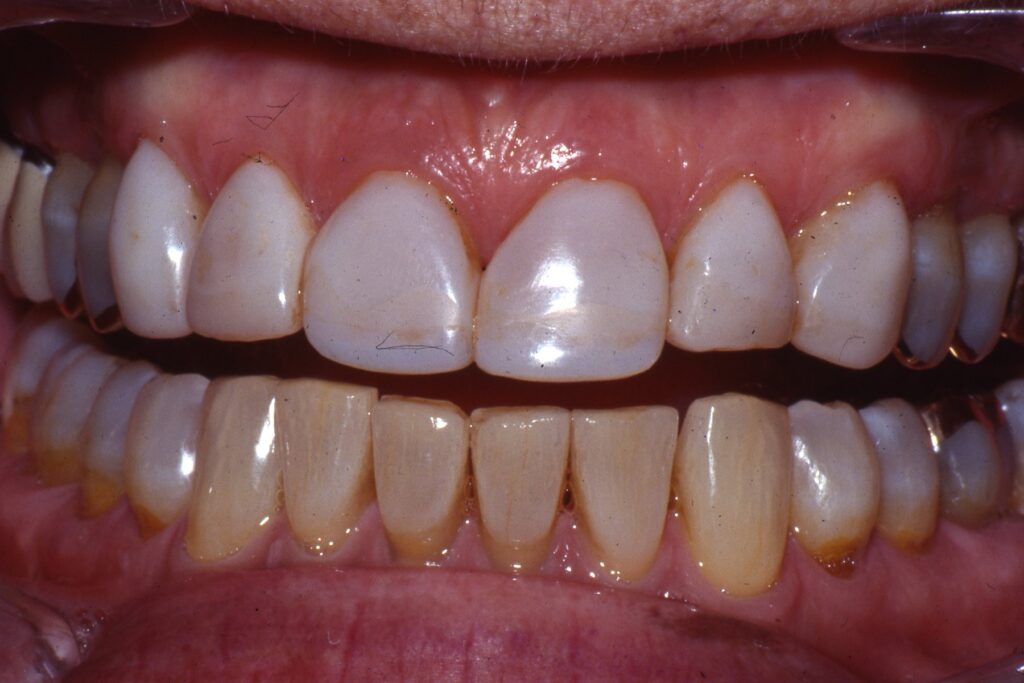
Note above the pasty appearance and unnatural shape of the upper teeth with the veneering.
Also, note that there are FIVE GOLD ONLAYS in the field of view, and yet they are hard to see. These are Esthetic Gold Restorations – and now we see why. The remaining natural tooth enamel on the facial surfaces allow the teeth to blend in with the adjacent teeth, and yet the gold on the cusps is NOT reflecting light back out of the mouth, except for two teeth of the three on the patients left side, and this will not happen with the lips closed to a conversational degree.
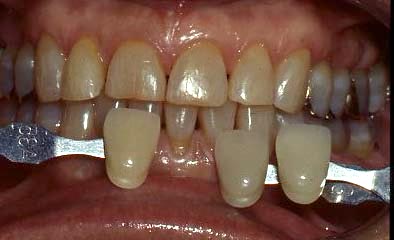
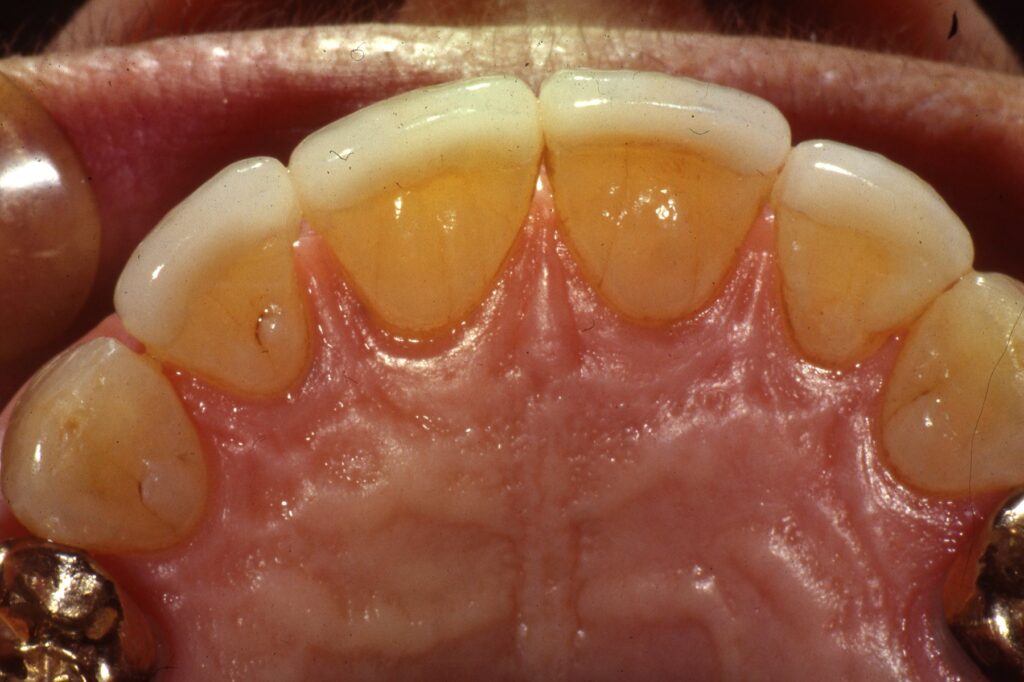
The Canines were Done Later
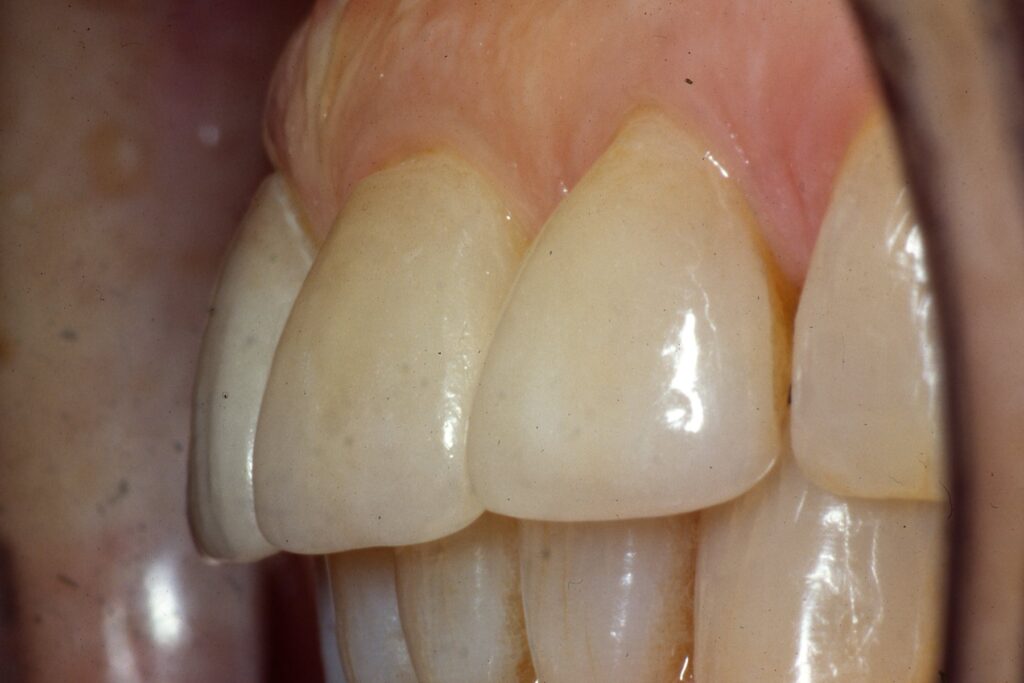
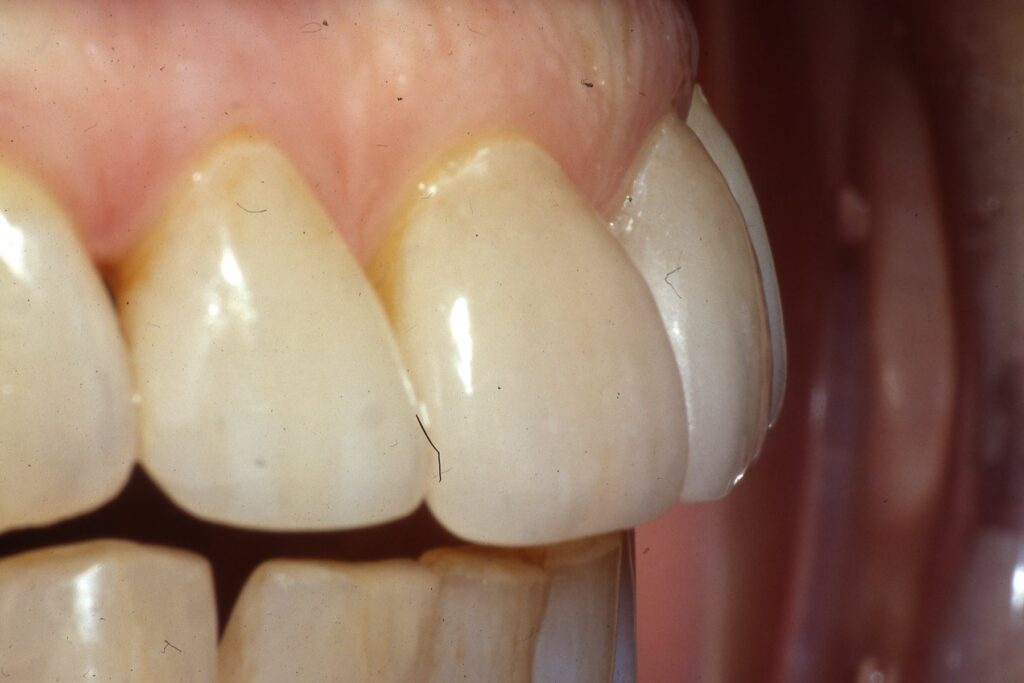
What IS a Cosmetic Dentist?
It is any dentist who wants to advertise as such! They advertise to attract patients who care primarily about their appearance. They may be well versed in all procedures that are done strictly for cosmetic purposes, but will they do a good job with any needed restoration that has an esthetic impact? Do they still have YOUR best dental interests firmly in mind?
The problem is that when the field of “Cosmetic Dentistry” was invented, with the advent of composite resin technology, it was seen as a financial boon to all dentists. Hence so many office signs that declare “Family and Cosmetic Dentistry”.
Dental procedures that are done solely for esthetic or cosmetic purposes, or that are done for restorative reasons but have large esthetic impact, must be considered carefully. There are often compromises that can be made, and need to be made, based on longevity considerations, patient finances, optimum cosmetic result, potential damage to surrounding structures, etc. The careful consideration of these options is what makes a good dentist good, or a great dentist great. For some patients you just make a crown and cement it in and they are happy, even if it is substandard esthetically. For some patients everything has to be perfect. And for ALL patients, the restorations you are doing must be optimum so that they will last long as possible in the patient’s mouth.
A porcelain crown in Beverly Hills costs far more than most other places. You might pay $1500 in a typical town, and $4000 in Beverly Hills. Why is this? Most obvious is the office rent and need for high end furnishings and appointments in the office so that the wealthy patients will feel at home. The other reason is that the typical patient will return several times to have things adjusted or replaced. They might be perfectly happy, but when they show their lunch group what you did and ask for comments, someone will have to make a negative comment, and the change has to be made. This is probably the largest component of the cost of doing the crown for the dentist.
There are dentists who advertise to do your whole mouth with porcelain crowns as an esthetic procedure. We will see (in Chapter V.15) what is involved in full mouth reconstruction, and it is far more sophisticated than most dentists realize. If the dentist is a prosthodontist, with board certification in this specialty, there is a good chance they have experience doing many cases like this, with varying degrees of complexity. But typical dentists do not have this experience.
For example, when ALL of the teeth are crowned, you are potentially changing the bite. If the teeth on the two arches bite down differently than previously, then the condyle of the TMJ may move out of the joint socket as the patient bites down. This can be very destructive to the joint, to say nothing of the pain that it might cause. It is common for prosthodontists experienced in this work to redo cases done by dentists over-reaching their experience and knowledge. I was trained by one of the country’s most notable practitioners specializing in full mouth rehabilitation, as I did one case under his guidance. I have a profound respect for those that have mastered this difficult art, and little respect for those who make the attempt without doing their homework. And – the cases can easily cost $100,000 – so the dentists responsibility to the patient is clearly set.
Bottom Line for Cosmetic Dentistry
This is the fourth Chapter of this site dealing with esthetic concerns of patients.
Clearly, the teeth and surrounding structures are extremely important in determining how we look to others, and how we feel about ourselves.
What the dentist does that can impact this must be done with considerable care and concern.
Anything that the dentist does in your mouth needs to be done with concern for solving the problem, doing it in a way that will last a long time and be consistent with your financial resources, AND it should either not impact your appearance adversely, OR make you look even better than you do.
It is the responsibility of the dentist to accomplish what you need and what you want, and to navigate the sometimes fine-line between what is best for you and what you want.
The “cosmetic dentist” has decided to optimize their practice for those patients whose primary interest is in their appearance. They may be particularly skilled and gifted at certain types of restorations, which need to be done with more of an artistic flare than might be the case for many dentists. The dentist CAN be as important as the cosmetic surgeon in changing someone’s appearance.
But, doing dentistry strictly for cosmetic purposes is a big responsibility. Not only does the cosmetic dentist need to make the patient feel they are more beautiful, but they have to do GOOD dentistry at the same time – without doing damage that may have repercussions only later.
It is very difficult to find a dentist specializing in cosmetics that we can trust to have MORE than just our appearance in mind. While the primary job is cosmetic, the consequences need to be discussed thoroughly, and decisions made based on functional and longevity concerns as well.
They are out there – and if you are in the market for cosmetic dentistry, I hope that this site will help you choose wisely.